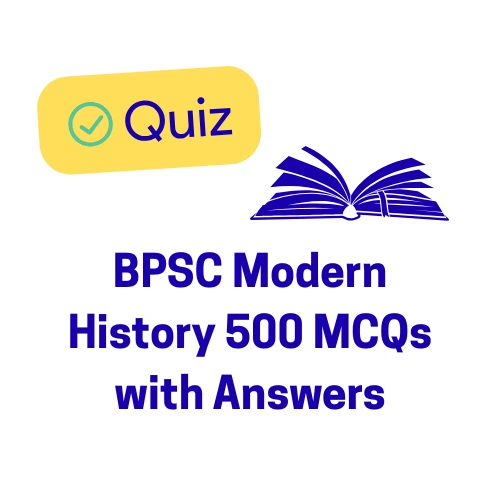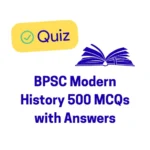BPSC Modern History Part 14 (500 MCQs) focus on the Interim Government, Mountbatten Plan, Partition, Integration of States, and the major political/cultural figures of the period (1946-1950).
BPSC Modern History Part 14 (500 MCQs)
Section JJ: Interim Government and Constitutional Developments
Q391. The Interim Government was formed in September 1946, based on the framework provided by the:
(A) Cripps Mission
(B) Wavell Plan
(C) Cabinet Mission Plan
(D) Mountbatten Plan
Q392. Who served as the Vice-President of the Viceroy’s Executive Council (de facto head) in the Interim Government?
(A) Lord Wavell
(B) Jawaharlal Nehru
(C) Sardar Vallabhbhai Patel
(D) Muhammad Ali Jinnah
Q393. Initially, the Muslim League boycotted the Interim Government. They finally joined in October 1946, under the leadership of:
(A) Muhammad Ali Jinnah
(B) Liaquat Ali Khan
(C) H. S. Suhrawardy
(D) Khwaja Nazimuddin
Q394. The Constituent Assembly of India held its first meeting on:
(A) August 15, 1947
(B) December 9, 1946
(C) January 26, 1950
(D) October 26, 1946
Q395. Who was elected as the temporary interim President of the Constituent Assembly in its first meeting?
(A) Dr. Rajendra Prasad
(B) Dr. Sachchidananda Sinha
(C) B. N. Rau
(D) Jawaharlal Nehru
BPSC Modern History Part 14 (500 MCQs)
Q396. Who was elected as the permanent President of the Constituent Assembly?
(A) Jawaharlal Nehru
(B) Dr. B. R. Ambedkar
(C) Dr. Rajendra Prasad
(D) Sardar Vallabhbhai Patel
Q397. The Objectives Resolution, which laid down the philosophical foundations of the Constitution, was moved in the Constituent Assembly by:
(A) Dr. B. R. Ambedkar
(B) Sardar Vallabhbhai Patel
(C) Jawaharlal Nehru
(D) B. N. Rau
Q398. In February 1947, the British Prime Minister Clement Attlee declared that British rule would end in India by:
(A) June 1947
(B) August 1947
(C) June 1948
(D) January 1950
Q399. The last Viceroy of India, who was specifically tasked with the transfer of power by the Attlee government, was:
(A) Lord Wavell
(B) Lord Mountbatten
(C) Lord Linlithgow
(D) Lord Curzon
Q400. Who was the first Governor-General of free India (1947-1948)?
(A) C. Rajagopalachari
(B) Lord Mountbatten
(C) Jawaharlal Nehru
(D) Dr. Rajendra Prasad
Section KK: Mountbatten Plan, Partition, and Integration of States
Q401. The Mountbatten Plan (also known as the June 3rd Plan) for the partition of India provided for:
(A) Referendum in the North-West Frontier Province (NWFP) and Sylhet (Assam).
(B) Boundary Commission to demarcate borders in Bengal and Punjab.
(C) Partition of the provinces of Bengal and Punjab.
(D) All of the above
Q402. The Indian Independence Act was passed by the British Parliament and came into force in:
(A) July 1947
(B) August 1947
(C) June 1947
(D) December 1947
Q403. The Boundary Commission responsible for demarcating the boundaries between India and Pakistan was headed by:
(A) Lord Mountbatten
(B) Sir Cyril Radcliffe
(C) Sir Stafford Cripps
(D) Clement Attlee
Q404. Which of the following Princely States initially refused to join the Indian Union after independence?
Junagadh
Hyderabad
Jammu & Kashmir
(A) 1 and 2 only
(B) 2 and 3 only
(C) 1 and 3 only
(D) 1, 2, and 3
BPSC Modern History Part 14 (500 MCQs)
Q405. The accession of the Princely State of Junagadh to India was secured through which method?
(A) Military Action (Operation Polo)
(B) Plebiscite (Referendum)
(C) Instrument of Accession signed by the Nawab
(D) Direct negotiation with the British
Q406. The Princely State of Hyderabad was integrated into the Indian Union through a military operation known as:
(A) Operation Vijay
(B) Operation Polo
(C) Operation Blue Star
(D) Operation Cactus
Q407. Who played the pivotal role in the integration of the 500+ Princely States into the Indian Union?
(A) Jawaharlal Nehru
(B) Dr. Rajendra Prasad
(C) Sardar Vallabhbhai Patel
(D) V. P. Menon
(E) More than one of the above
Q408. The last Governor-General of India (Indian) before the country became a Republic was:
(A) Jawaharlal Nehru
(B) Dr. Rajendra Prasad
(C) C. Rajagopalachari
(D) Lord Mountbatten
Q409. The Preamble of the Indian Constitution is based on the final shape of the:
(A) August Offer
(B) Cripps Proposal
(C) Objectives Resolution
(D) Nehru Report
(E) None of the above / More than one of the above
Answer: (C) Objectives Resolution
Q410. India became a Sovereign Democratic Republic on January 26, 1950. Which event/day is celebrated on this date?
(A) Independence Day
(B) Republic Day
(C) Purna Swaraj Day
(D) Constitution Day
Section LL: Key Personalities, Books, and Acts
Q411. Who was the Chairman of the Drafting Committee of the Constituent Assembly?
(A) Dr. Rajendra Prasad
(B) Dr. B. R. Ambedkar
(C) K. M. Munshi
(D) Alladi Krishnaswami Ayyar
Q412. The phrase ‘Tryst with Destiny’ is associated with the speech delivered by which leader on the eve of India’s independence (August 14/15, 1947)?
(A) Mahatma Gandhi
(B) Sardar Vallabhbhai Patel
(C) Jawaharlal Nehru
(D) Subhas Chandra Bose
Q413. The book ‘India Divided’, detailing the events leading to partition, was written by:
(A) B. R. Ambedkar
(B) Dr. Rajendra Prasad
(C) Maulana Abul Kalam Azad
(D) Jawaharlal Nehru
Q414. Who wrote the book ‘The Discovery of India’ while imprisoned in Ahmednagar Fort during the Quit India Movement?
(A) Rabindranath Tagore
(B) Mahatma Gandhi
(C) Jawaharlal Nehru
(D) S. Radhakrishnan
Q415. The famous poem ‘Where the Mind is Without Fear’ is associated with which Indian personality?
(A) Bankim Chandra Chatterjee
(B) Rabindranath Tagore
(C) Subramania Bharati
(D) Muhammad Iqbal
BPSC Modern History Part 14 (500 MCQs)
Q416. Who was the editor of the English weekly ‘Young India’ and the Gujarati weekly ‘Navajivan’?
(A) B. G. Tilak
(B) Mahatma Gandhi
(C) Jawaharlal Nehru
(D) Lala Lajpat Rai
Q417. The journal ‘Bande Mataram’ was associated with which Extremist leader?
(A) Bipin Chandra Pal
(B) Aurobindo Ghosh
(C) B. G. Tilak
(D) Lala Lajpat Rai
Q418. Which social reformer and educationist was known as ‘Karmaveer’ and founded the Karve Institute of Social Service?
(A) Pandita Ramabai
(B) D. K. Karve
(C) Jyotiba Phule
(D) Ishwar Chandra Vidyasagar
Q419. The Indian Press Act (or Gagging Act) which imposed severe restrictions on the press during the Non-Cooperation movement was passed in which year?
(A) 1908
(B) 1910
(C) 1919
(D) 1922
Q420. The Sarda Act (Child Marriage Restraint Act) of 1929 fixed the minimum age for marriage for girls and boys at:
(A) Girls 14, Boys 18
(B) Girls 16, Boys 18
(C) Girls 14, Boys 21
(D) Girls 18, Boys 21

